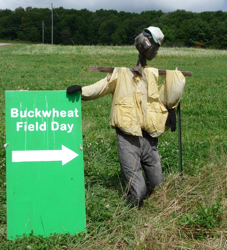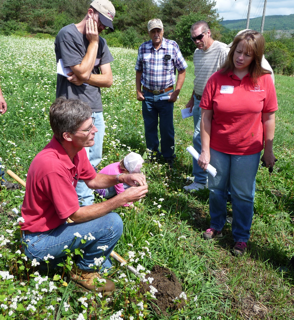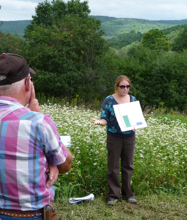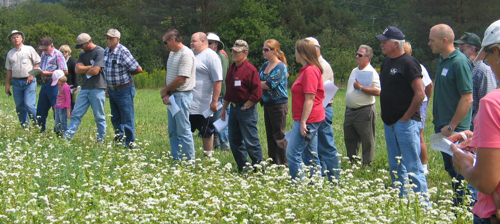Northeast Buckwheat Growers Newsletter
No. 30 September 2010 Click here for PDF version
Edited by Thomas Bjorkman, Cornell NYSAES, Geneva NY
- 2010 Field Day
- Production Notes – Scout for stem rot
- Koto buckwheat seed
- Research notes—buckwheat breeding
- Russian buckwheat frenzy
- Updated website
2010 Field Day
 The 2010 Northeast Buckwheat Field Day was hosted by Brian Baker and the Center for Organic and Sustainable Agriculture recently established at Alfred State University on August 24. NOFA-NY was a cosponsor this year.
The 2010 Northeast Buckwheat Field Day was hosted by Brian Baker and the Center for Organic and Sustainable Agriculture recently established at Alfred State University on August 24. NOFA-NY was a cosponsor this year.
The field day continues to be very popular, drawing a record fifty participants. The location was good for bringing more growers from Pennsylvania. Growers also had a change to talk with Birkett Mills owner Jeff Gifford, and vice president Cliff Orr.
Thomas Bjorkman of Cornell University demonstrated best management techniques for buckwheat grain production, and showed some practices to avoid and their consequences. Buckwheat grown with field preparation that resulted in different amounts of moisture for the see d, varied in its success. Good soil contact and preserving soil moisture were important factors for success. Incorporating organic matter too soon before planting had severe effects on stand and yield. Finally, row spacing showed a very visible effect. Seven-inch rows made a solid stand but twelve-inch rows had stripes of pigweed emerging between buckwheat rows.
d, varied in its success. Good soil contact and preserving soil moisture were important factors for success. Incorporating organic matter too soon before planting had severe effects on stand and yield. Finally, row spacing showed a very visible effect. Seven-inch rows made a solid stand but twelve-inch rows had stripes of pigweed emerging between buckwheat rows.
Angela Possinger described her research testing whether buckwheat would liberate bound soil phosphorus in a way that was useful to crops that follow. Her results agreed with the model that it has some potential on calcareous higher-pH soils, but wasn't a strong effect on the more acidic soils of New England and the southern Tier. 
Elizabeth Dyck described the benefits of local production and marketing of organic buckwheat seed for cover crop use. She is helping growers start up farm enterprises to be local supplies. Several of the growers in attendance said they saw potential for that enterprise on their farm.
Dr. Dyck also had a demonstrated cover crops used in the summer, and how they growing conditions affect how they are used. It featured buckwheat, sorghum-sudangrass, Japanese millet, phacelia, and crotalaria. Phacelia represents another opportunity to raise cover crops seed because it grows well but has no local supplier. Crotolaria is distinctive among legumes by being so vigorous that it suppresses weeds, but, being tropical, will not go to seed.
Production Notes – Scout for stem rot
 Fortunately, buckwheat has few disease problems. However, one is worth checking for when inspecting fields that may be getting close to harvest. That disease is Sclerotinia stem rot. The disease can be identified by finding some stems that are prematurely tan, with inch-long brown marks on the stem. The disease usually affects isolated stems, but it causes them to collapse quickly. The seeds on the collapsed plants will not make it into the bin, and will cause volunteers in the spring. The disease on each stem progresses quickly and causes the stem to drop. Therefore, you seldom see a lot at once, even if there is significant total loss. The only response to finding the disease is to harvest as soon as the grain will thresh of the plant. The challenge is to decide when yield loss from collapsed plants is worse than the high-moisture penalty of early harvest.
Fortunately, buckwheat has few disease problems. However, one is worth checking for when inspecting fields that may be getting close to harvest. That disease is Sclerotinia stem rot. The disease can be identified by finding some stems that are prematurely tan, with inch-long brown marks on the stem. The disease usually affects isolated stems, but it causes them to collapse quickly. The seeds on the collapsed plants will not make it into the bin, and will cause volunteers in the spring. The disease on each stem progresses quickly and causes the stem to drop. Therefore, you seldom see a lot at once, even if there is significant total loss. The only response to finding the disease is to harvest as soon as the grain will thresh of the plant. The challenge is to decide when yield loss from collapsed plants is worse than the high-moisture penalty of early harvest.
Koto buckwheat seed
Northeast growers have been producing the variety Koto in recent years. Cornell trials showed that this variety is superior to its predecessors, Manor and Manisoba. However, production of certified seed has been limited in the last two years. Seed department records show only about 34 acres of certified seed production in 2008 and 2009 combined. Thing are looking up, however. North Dakota seed department records show about 100 acres due to be harvested in 2010. However, no Koto seed is being produced in Manitoba. Jan Peterson of MinnDak Growers in Grand Forks, ND, says that their Certified Seed production is primarily destined for their contracted growers, but could be available to other licensees as well. Buckwheat acreage is up substantially in North Dakota this year
Research notes—buckwheat breeding
Clayton Campbell is the developer of most current buckwheat varieties from his breeding work at Agriculture Canada and Kade Research. With Kade closed, Dr. Campbell continues breeding privately. He is making good progress in two areas and anticipates establishing a new company based on this germplasm in a year or two. The two traits of interest are shattering resistance and a green groat. Shattering resistance could make a big difference for growers by increasing the time window for direct combining. It would allow more chances to harvest in good conditions and also allow the leaves to die more before harvest. The trait called "green testa" makes a bright green groat that is intended as a high-value specialty buckwheat for Japan and other luxury markets in Asia. Millers in Japan have expressed particular interest in being able to offer this type of buckwheat. All the variety development by Dr. Campbell is based on self-compatible lines.
There is a new breeder at Washington State University named Kevin Murphy. In this, his first year, he has begun by doing variety trials in parts of the state where buckwheat has not been widely grown.
Russian buckwheat frenzy
The Russian drought has impacted buckwheat supplies there. Since buckwheat is such a valued part of the diet, hoarding was reported and rationing was introduced in Ukraine.
| 2008 Producer price | |
|---|---|
| Country of production | $/metric ton |
| Belarus | 270 |
| Canada | 319 |
| China | 443 |
| Estonia | 121 |
| France | 242 |
| Japan | 2,010 |
| Lithuania | 281 |
| Korea | 908 |
| Russia | 249 |
| Ukraine | 269 |
| USA | 186 |
| Source: FAO | |
The harvest is expected to be about 60% of the normal 300 thousand ton crop. In August, the retail price rose from thirty cents a pound to over a dollar according to Interfax. TASS reported that wholesale prices traded as high as $1500 per ton! Compare that with the 2008 producer price of $250 (see table at right).
Russian and Ukrainian officials expect prices to go back down once the 2010 harvest begins to enter markets in September.
The crisis was even covered in the New York Times on September 6. They quote a Russian shopper as saying “it is a classic, Soviet-style panic”. President Medvedeev has been visiting provincial centers to reassure people that there would be buckwheat. With the stress from heat, drought and forest fires, the response of the public seems to be focused on buckwheat.
To put Russian prices in the international context, the table at the right shows earlier producer prices in different countries. For comparison, the 2010 Birkett Mills price of $20 per hundredweight is $440 per metric ton.
Japan stands out as being about ten times as high as everywhere else, and that helps explain why they are eager to import.
Updated buckwheat website
Regular visitors to the Cornell buckwheat website know that it has not been aging gracefully. Thanks to Cornell undergraduate Andrea Shapiro, the website now has the look of a normal Cornell website.
All the good information is still there, and now it is easier to add new material. The site has been designed so that it still works for the farms that are beyond the reach of broadband internet. That number has been declining in the website statistics, and I hope the reason is better service to rural areas.
Previous | Next
